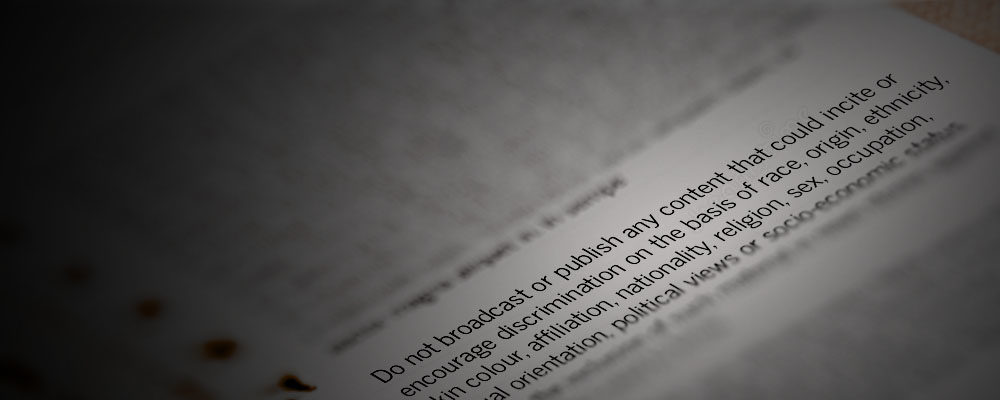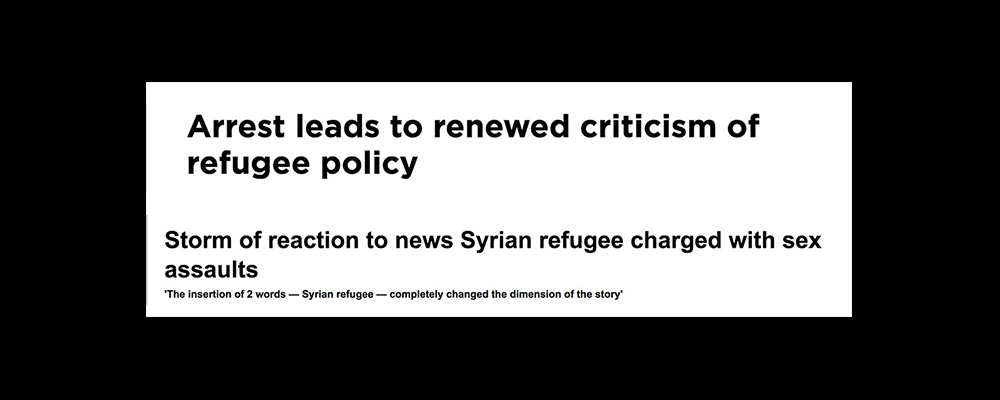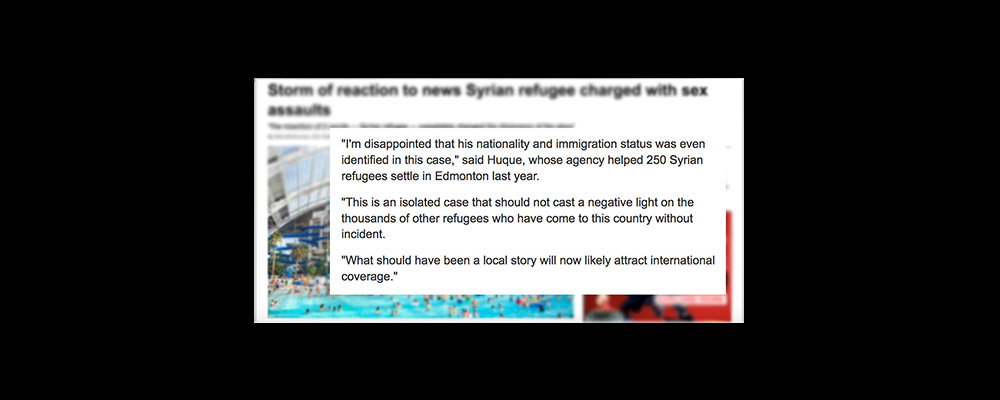


Happening Today
Sorry, event listing is not available.

Making The Right Call
Journalism has never been an easy job – and the simultaneous rise of alternative facts, social media and confrontation culture has made reporting even more difficult. Now more than ever, it’s imperative that journalists take steps to ensure something they put into the world doesn’t become fuel for the fire of those with a racist, sexist or terrorist agenda.
Written by Jeff Samsonow
TLDR
Journalists must consider why something is included in their story. Otherwise it could be twisted into misinformation and hateful rhetoric.
Just over a week ago, Edmontonians were confronted with a disturbing story a about series of sexual assaults that happened at the West Edmonton Mall water park.
As happens regularly with crime stories in our city, Edmonton Police put out a news release, newsrooms picked it up and outlets ran stories about six teen girls who had been assaulted. A handful of Edmonton newsrooms, however, added another detail to the story.
They mentioned the accused was a Syrian refugee.

The decision to mention the refugee status quickly spun the story away from being about the sexual assault of underage girls; instead, it became a talking point for anti-refugee and anti-immigration vitriol online. Instead of discussing cause and prevention of sexual crime – a rampant issue for Canadians that long pre-dates our welcoming of Syrian refugees – the outcry was one of rage against refugees, with calls for deportations and numerous expressions of xenophobia, racism and nationalism.
Context Matters
Thinking about what goes into a story isn’t enough anymore. Journalists must now consider intention behind including certain facts and details in their stories, as well as the potential reactions from the audience. There is risk that people will get hurt if a misplaced detail becomes fodder for those who would do the worst.
Sexual Assaults: All-too common
This discussion stems from a story about sexual assaults. That’s a crime that occurs regularly in Edmonton – more than one case reported to police every day – with most cases never even reported to police.
Annette Klevgaard, public educator, community engagement at the Sexual Assault Centre of Edmonton (SACE) says it’s important for stories of sexual assault to focus on the factors that lead to the crime.
“Communities need to continually engage in conversations that highlight and scrutinize the attitudes and beliefs that contribute to the continuation of sexual violence. The anti-immigration rhetoric that this story has spawned detracts from the reality that sexual violence happens in all communities and is perpetrated by individuals of all backgrounds.”
As Klevgaard reminds us, sexual assault is remarkably common. “Media stories often focus on the small proportion of sexual assaults perpetrated by strangers. This focus may make it difficult for people to reach out for support if they have been sexually assaulted by someone that they, their friends, their families, and their communities know.”
New sexual assault research, directly from Edmonton Police Service case files confirms this. More than one sexual assault is reported to police every single day in Edmonton, with the majority occurring between people who know each other (family, friends, intimate partners).
High-profile cases of child abuse – and we are talking about teenagers in these West Edmonton Mall assaults – are an opportunity to spark conversation about believing and supporting too.
Lauren Andrews, communications specialist at the Zebra Child Protection Centre (which supports children who have experienced abuse) says more than 1,500 children and youth received support from the Zebra Centre last year.
“While we still need to properly prepare our children to be safe, the concept of ‘stranger danger’ is outdated. Instead, we must empower our children to establish personal boundaries, follow their instincts and come forward when something doesn’t feel right,” continues Andrews.
“In 2016, the victim was known to the offender in nearly 90 per cent of the files supported by Zebra Centre. It happens in people’s homes, schools, community groups, through a child’s smart phone and sometimes in a very public place.”
If you would like to learn more about SACE or the Zebra Centre please visit their websites. There’s good information on the work they do, how to report sexual assault and the support available here in Edmonton.
Brian Gorman is an associate professor of communications studies at MacEwan University, and teaches students studying journalism.
“The main test journalists apply to an ethical issue is, ‘Can I justify my decision?’ And, under the CAJ guideline [Canadian Association of Journalists], the main question is: ‘Is the man’s national origin pertinent in this case?’”
Gorman cautions that including details such as someone’s race or background must be considered carefully, because it has to be absolutely integral to the story being told.
“It would be rather disingenuous for anyone to say he or she is unaware of the overheated atmosphere surrounding the issues related to the Syrian refugees, or of how vulnerable the members of this community are. And the answer would likely be no, to the question of whether you would report if the man were Irish, Jewish, British, African-American or Aboriginal. What does his ethnicity say about the incident? What does the incident say about his ethnic group? In both cases, the answer is, nothing.”
Making the Call
The Managing Editor of Global Edmonton, Kerry Powell, says her newsroom concluded the refugee status was relevant because of public debate around Syrians fleeing their war-torn home.
“We weighed the public’s need to know against the concern that such information could encourage discrimination. In this case, because of the sometimes heated public debate in Canada over screening of refugees – particularly, in the past 18 months, Syrian refugees – we chose the former. We see our role as journalists to provide the audience with accurate, relevant, balanced and timely information so they can form their own conclusions about the success or failure of the Syrian refugee program in Canada.”
CBC’s senior manager of journalism, programming, Gary Cunliffe, provided a brief answer as to why his newsrooms included the detail.
“CBC Edmonton made the decision to publish all details of the story because, as with all stories we publish/broadcast, we deemed it newsworthy. Given the legal status of the accused as a refugee and what the future holds for him we decided it was important to the understanding of the whole story.”
Ethical Guidelines
The ethical guidelines used by the newsrooms of Global Edmonton and CBC Edmonton were provided in response to initial questions about why the refugee status was included in their stories.
Global guidelines:
“Do not broadcast or publish any content that could incite or encourage discrimination on the basis of race, origin, ethnicity, skin colour, affiliation, nationality, religion, sex, occupation, sexual orientation, political views or socio-economic status. Weigh the inclusion of such material in news stories against the public’s need to know. Do not provide a platform for racism and discrimination, but be cautious not to sanitize coverage of these issues.”
CBC guidelines:
“We are aware of our influence on how minorities or vulnerable groups are perceived. We do not mention national or ethnic origin, colour, religious affiliation, physical characteristics or disabilities, mental illness, sexual orientation or age except when important to an understanding of the subject or when a person is the object of a search and such personal characteristics will facilitate identification.”
Why vs. What
One of the local newsrooms that did not include the accused’s refugee status was that of Postmedia’s newspapers, the Edmonton Journal and Edmonton Sun. Mark Iype is Editor In Chief.
“I feel in my judgment, we did the right thing. There was debate among the editors about what to do, but in the end, it is my call. That being said, it was one of the tougher decisions I’ve had to make in my current role as Editor in chief and in previous editor positions.”
It should be noted that other Postmedia newsrooms, in Calgary and Toronto, did run items in defense of including the information. They focused on whether or not journalists should keep information out of stories – the what – as opposed to the implications of running something – the why. But the issue here is not one of suppression of facts or censorship.
 Image: Reaction from the Edmonton Mennonite Centre for Newcomers. Screencap details courtesy of Global News.
Image: Reaction from the Edmonton Mennonite Centre for Newcomers. Screencap details courtesy of Global News.
MacEwan’s Gorman says journalists need to consider what will happen after they run a story.
“If there were a wave of crimes being committed by one ethnic group, or if we were being flooded with released prisoners, there might be a story there, but still one that would need to be handled with care and put in context. By reporting ethnicity, you provide anecdotal evidence to unscrupulous spin-doctors who can use your story to influence public opinion.”
Indeed, this story has sparked just that kind of spin. From people saying it’s proof of some kind of criminal or terrorist invasion, to outlets like The Rebel trumpeting imagined crime waves by Syrian refugees, one thing is clear: the focus is no longer on the crime itself.

Image: Facebook comments, courtesy Global Edmonton.
Consider the Reaction
CBC had a follow-up story on the reaction their reporting caused. It included Islamic, immigrant services and journalism voices, all of whom questioned why the detail was included.
Global also included Muslim and immigrant services voices in a follow-up. Their story claimed the original report renewed criticism of Canada accepting 25,000 people leaving Syria’s war zones. Most of that new criticism appears to be from their Facebook page.
 Image: Reaction from the Islamic Family and Social Services Association. Screencap details courtesy of CBC.
Image: Reaction from the Islamic Family and Social Services Association. Screencap details courtesy of CBC.
Global Edmonton’s Kerry Powell doesn’t think including comments from their Facebook page gives the opinions a platform.
“It’s about providing balance and representing diverse views, even when they may not be pleasant or popular. We are living in a period of political extremes and polarized opinions. To report only on the middle ground would not be a true expression of how Canadians feel. It’s our responsibility to reflect the views of our community, and the fact is, many Albertans believe there ought to be stricter controls on immigration, and specifically on Syrian refugees.”
At the Postmedia newsroom, Mark Iype says just because some people believe stricter vetting of refugees is required doesn’t mean that opinion has relevance in every story.
“We aren’t out to suppress views, but we do get to decide what we run and how we run it. And that goes for comments. We get to decide whether something is appropriate or not and we are the arbiters of that. Is it a grey area? Absolutely, because it is a judgment call.”
Powell believes this speaks to journalistic need to put all the facts in front of people.
“Global Edmonton didn’t create the outrage. We reported accurately and fairly on events that transpired, and included details that are available for anyone to find online. It was editorially responsible to report on the outrage, to show that anti-immigration sentiment is rife in our community, and to give voice to those who say it’s wrong to let the alleged crimes of one person tar an entire group. It’s always better to report the truth, not to hide it.”
Neither Global Edmonton nor CBC Edmonton answered follow-up questions. 630 CHED and iNews880 did not respond to a request for comment.
Who We Talked To
Newsrooms that included the refugee status are Global Edmonton, 630 CHED, iNews880 and CBC Edmonton. We contacted each newsroom for comment on why they included the refugee status in a story about sexual assaults.
Global Edmonton answered some of our questions by email. Radio stations CHED and iNews referred us to Global Edmonton for comment (all three are owned by Corus Entertainment and share newsroom resources). The radio stations did not respond to a further request for their own response.
CBC Edmonton provided a brief response by email. The newsroom, which includes radio, TV and online resources, did not provide answers to further questions.
Reporting in the Public Interest
So are these conflicting opinions from Edmonton newsrooms indicative of conspiracy or bias?
Brian Gorman says no.
“I would hardly accuse Global or CBC of playing the Rebel, Daily Mail, Fox or MSNBC game of spinning controversy to attract views. In this case, I think it’s a simple lapse, and probably under deadline pressure. Somehow, no one asked the question, ‘Why are we reporting this?’”
The journalist and MacEwan associate professor says this type of self-questioning can get overlooked in a the current economic media environment.
“[The failure to ask ‘Why are we reporting this?’] reflects more on reduced newsroom resources, and the reallocation of the remaining resources from reporting, editing and fact-checking to strictly news-gathering. The sober-second-thought side of journalism has taken one of the biggest hits in newsroom cutbacks. And it shows in instances like this.”
The volatile political climate we’re living in, and the speed of both lies and truth across the Internet mean journalists have to consider more than just what’s in their stories. They need to consider why something is in there and what reaction could be. Laying out facts and walking away doesn’t work anymore.
In the battle against “fake news” and “alternative facts”, another valuable weapon is transparency – explaining to the your audience why you made certain calls putting together a story.
In this case, it’s too late. The story has made the rounds on websites we’d rather not link you to and you can see the kinds of anger and hate it’s whipped up on Facebook and social media. It’s not too late, however, to ask more of journalists we trust to provide us information and insight. If a journalist’s intentions for including certain details aren’t clear, the wrong kinds of actions or reactions may be the result.
Journalism has never been easy – least of all in modern newsrooms stripped of staff, specialization and time. But journalists can make due with what’s available. We can create our own checks and balances by questioning every fact we include, every phrase we write and every choice we make.
The problem isn’t our ability to fact-check. The problem is our ability to self-assess. Existing codes of ethics can provide guidelines for news-gathering and storytelling, but they can’t preclude a journalist or newsrooms’ own biases and privilege.
This challenge is the future of reporting in the public interest. We must rise to the occasion.
Disclosures
Jeff Samsonow has previously worked for Corus Entertainment and Postmedia.
If you enjoyed this story, and want to see more like it, consider supporting us.
Support EQ